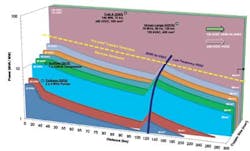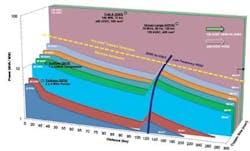Mac McKee
Larry Forster
John Allen
Richard Voight
INTECSEA
The offshore oil and gas industry was pioneered by risk takers and innovative thinkers. The boundaries of possibility have been and continue to be pushed further from shore and into deeper water. With these advances have come increased challenges, but also increased risks, in magnitude and severity of consequence. In turn, the industry has responded with an ever-increasing emphasis on system integrity.
In today's market, innovations which have matured through industry-accepted technology readiness level evaluations must then confront a risk-adverse culture where few companies put up their hands to be serial number 01. However, those few companies do exist and the industry continues to push forward, as evidenced by the growth and development of the subsea processing market.
Currently, subsea processing projects can be found in nearly every major offshore oil and gas region in the world, with the North Sea and offshore Brazil (Campos and Espirito Santo basins) experiencing the most activity to date. While still an emerging market, with the number of installed systems relatively small (about 30), recognition of the potential returns, and hence the level of acceptance of subsea processing technologies, continues to increase. Subsea processing is now appearing in development options for many industry projects.
Subsea processing defined
Subsea processing is the application of hydrocarbon processing equipment at the seafloor. Traditionally, these seafloor systems comprised subsea separation, boosting, and gas compression equipment, as well as the associated enabling components for electrical power transmission, distribution, and subsea controls. The most mature of these technologies is subsea boosting, followed by separation and compression.
The use of subsea boosting has increased fairly steadily with increasing power and water depth. These trends can be seen with the upcoming commissioning of Jack/St. Malo (Chevron) and the Julia (ExxonMobil) fields, both in the Gulf of Mexico. Subsea separation is expected to proliferate due to its impact on high water-cut production, common in aging reservoirs. Subsea separation has a mixed history, including the recent notable success of the Total Pazflor system operating offshore West Africa. Major subsea gas compression projects, particularly Ormen Lange, Asgard, and Gullfaks, are in their final development stages and their outcomes will significantly impact future developments.
Subsea processing rewards
The application of subsea processing equipment spans the operational life cycle, from greenfield to brownfield developments, with the ultimate goal of increasing recoverable reserves through more effective field management. These technologies have the potential to convert marginal fields into economically viable developments; to overcome deepwater and environmental challenges, such as flow assurance; and to extend the production life of a mature reservoir. Additionally, the reduction in size, or possibly the elimination altogether of the otherwise required topside facility can significantly reduce both capex and opex, thus making subsea processing a high-value investment.
While an increase in overall recovery is the primary reward of subsea processing, there are inherent benefits associated with the development and implementation of new technologies. This atmosphere fosters increased competition, which in turn drives innovation.
Electrical power transmission
This year's Subsea Boosting and Processing poster, developed by INTECSEA and published byOffshore, has a new section with a special focus on subsea power transmission. This section shows the maturity and the diversity of power solutions now emerging.
Supplying and managing electrical power to subsea processing systems has been recognized as a significant challenge. But these same challenges - the distances involved, the power levels, and the economies of scale - have resulted in a wider array of equipment types. Additionally, each type of equipment represents a significant investment as well as (most likely) a particular installation challenge.
As subsea processing matures, methods for delivering power to these installations are becoming clearer, common equipment types are beginning to take shape, and systems-level considerations are becoming even more apparent. Distinct categories of power delivery systems are also beginning to emerge, all tailored to delivering increasing levels of power over longer distances in subsea environments.
There are a number of factors to consider when reviewing power supply options for subsea processing systems. For moderate power and relatively short distances from the host facility, conventional 50/60 Hz AC can suffice. As distances and power levels increase, other options such as low frequency AC can be advantageous. For relatively high power and long-distance applications (as seen on Ormen Lange), significantly higher AC voltages may be employed. Complexities with the use of AC power have also led to the consideration of high voltage DC, which is currently undergoing research for anticipated future applications.
Looking to the future
With state-of-the-art technologies being implemented or proposed, and many other solutions being considered or tested, it is clear that the subsea processing market remains one of the most innovative within the offshore industry.
The industry is, however, still in the midst of establishing reliable data for subsea processing technologies. As this data is collected and used to improve upon currently available equipment, the application of subsea processing will continue to be driven in the near term by the industry's risk-takers. Few can doubt that the future of subsea processing looks remarkably promising, especially as developments become more challenging and operators drive for increased overall recovery.
Subsea processing poster
This issue of Offshore contains the 2013 Worldwide Survey of Subsea Processing Systems, the sixth installment of this industry resource. This survey is on the Subsea Boosting and Processing poster. The primary aims of this poster are to chronicle the development and developers of these systems, and to document the continued commitment of oil companies to the application of these technologies. For online access to view and download, visitwww.offshore-mag.com/maps-posters.html.
Offshore Articles Archives
View Oil and Gas Articles on PennEnergy.com




